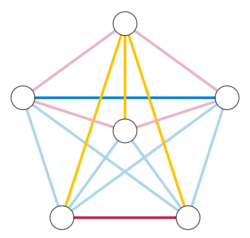Graham–Pollak theorem
 From HandWiki - Reading time: 5 min
From HandWiki - Reading time: 5 min
In graph theory, the Graham–Pollak theorem states that the edges of an
The theorem has since become well known and repeatedly studied and generalized in graph theory, in part because of its elegant proof using techniques from algebraic graph theory.[4][5][6][7][8] More strongly, (Aigner Ziegler) write that all proofs are somehow based on linear algebra: "no combinatorial proof for this result is known".[1]
Construction of an optimal partition
A partition into exactly
Proof of optimality
The proof of the Graham–Pollak theorem described by (Aigner Ziegler) (following Tverberg 1982) defines a real variable
Then, in terms of this notation, the fact that the bipartite graphs partition the edges of the complete graph can be expressed as the equation
Now consider the system of linear equations that sets
But a sum of squares of real variables can only be zero if all the individual variables are zero, the trivial solution to the system of linear equations.
If there were fewer than
Related problems
Distance labeling
Graham and Pollak study a more general graph labeling problem, in which the vertices of a graph should be labeled with equal-length strings of the characters "0", "1", and "✶", in such a way that the distance between any two vertices equals the number of string positions where one vertex is labeled with a 0 and the other is labeled with a 1. A labeling like this with no "✶" characters would give an isometric embedding into a hypercube, something that is only possible for graphs that are partial cubes, and in one of their papers Graham and Pollak call a labeling that allows "✶" characters an embedding into a "squashed cube".[3]
For each position of the label strings, one can define a complete bipartite graph in which one side of the bipartition consists of the vertices labeled with 0 in that position and the other side consists of the vertices labeled with 1, omitting the vertices labeled "✶". For the complete graph, every two vertices are at distance one from each other, so every edge must belong to exactly one of these complete bipartite graphs. In this way, a labeling of this type for the complete graph corresponds to a partition of its edges into complete bipartite graphs, with the lengths of the labels corresponding to the number of graphs in the partition.[3]
Alon–Saks–Seymour conjecture
Noga Alon, Michael Saks, and Paul Seymour formulated a conjecture in the early 1990s that, if true, would significantly generalize the Graham–Pollak theorem: they conjectured that, whenever a graph of chromatic number
Biclique partition
The biclique partition problem takes as input an arbitrary undirected graph, and asks for a partition of its edges into a minimum number of complete bipartite graphs. It is NP-hard, but fixed-parameter tractable. The best approximation algorithm known for the problem has an approximation ratio of
References
- ↑ 1.0 1.1 1.2 1.3 Proofs from THE BOOK (6th ed.), Springer, 2018, pp. 79–80, doi:10.1007/978-3-662-57265-8, ISBN 978-3-662-57265-8
- ↑ "On the addressing problem for loop switching", The Bell System Technical Journal 50: 2495–2519, 1971, doi:10.1002/j.1538-7305.1971.tb02618.x
- ↑ 3.0 3.1 3.2 "On embedding graphs in squashed cubes", Graph theory and applications (Proc. Conf., Western Michigan Univ., Kalamazoo, Mich., 1972; dedicated to the memory of J. W. T. Youngs), Lecture Notes in Mathematics, 303, 1972, pp. 99–110
- ↑ 4.0 4.1 "On the decomposition of
- ↑ "A new proof of a theorem of Graham and Pollak", Discrete Mathematics 49 (3): 327–328, 1984, doi:10.1016/0012-365X(84)90174-2
- ↑ Cioabă, Sebastian M.; Tait, Michael (2013), "Variations on a theme of Graham and Pollak", Discrete Mathematics 313 (5): 665–676, doi:10.1016/j.disc.2012.12.001
- ↑ Vishwanathan, Sundar (2013), "A counting proof of the Graham-Pollak theorem", Discrete Mathematics 313 (6): 765–766, doi:10.1016/j.disc.2012.12.017
- ↑ "Improved bounds for the Graham-Pollak problem for hypergraphs", Electronic Journal of Combinatorics 25 (1): Paper No. 1.4, 2018
- ↑ Huang, Hao (2012), "A counterexample to the Alon–Saks–Seymour conjecture and related problems", Combinatorica 32 (2): 205–219, doi:10.1007/s00493-012-2746-4
- ↑ Balodis, Kaspars; Ben-David, Shalev; Göös, Mika; Jain, Siddhartha; Kothari, Robin (2021), "Unambiguous DNFs and Alon–Saks–Seymour", 62nd IEEE Annual Symposium on Foundations of Computer Science, FOCS 2021, Denver, CO, USA, February 7-10, 2022, pp. 116–124, doi:10.1109/FOCS52979.2021.00020
- ↑ Fleischner, Herbert; Mujuni, Egbert; Paulusma, Daniël; Szeider, Stefan (2009), "Covering graphs with few complete bipartite subgraphs", Theoretical Computer Science 410 (21-23): 2045–2053, doi:10.1016/j.tcs.2008.12.059
- ↑ Chandran, Sunil; Issac, Davis; Karrenbauer, Andreas (2017), "On the parameterized complexity of biclique cover and partition", in Guo, Jiong; Hermelin, Danny, 11th International Symposium on Parameterized and Exact Computation (IPEC 2016), Leibniz International Proceedings in Informatics (LIPIcs), 63, Dagstuhl, Germany: Schloss Dagstuhl–Leibniz-Zentrum fuer Informatik, pp. 11:1–11:13, doi:10.4230/LIPIcs.IPEC.2016.11, ISBN 978-3-95977-023-1
 |
20 views | Status: cached on September 20 2024 10:19:52
↧ Download this article as ZWI file
 KSF
KSF
